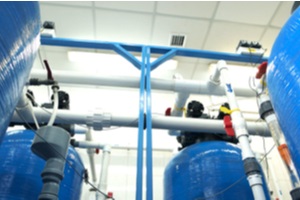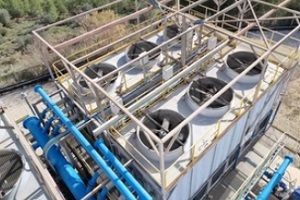Cooling towers manage water in order to regulate a facility’s temperature and reduce heat. How a cooling tower accomplishes this task will depend on the type of cooling tower in operation (e.g. a crossflow tower or a counterflow tower). Be aware that all cooling towers, no matter the type, lose a fair amount of water during normal operations.
Knowing how much water your cooling tower is utilizing can help you to predict your utility bills, as well as identify problem areas in need of repair. You can use a straightforward math formula to calculate your cooling tower’s total water loss on your own. You also have the option to hire an expert who can help you run the formula and verify its accuracy.
Where Does Cooling Tower Water Go?
Cooling towers lose water through several means. Evaporation is the most common (and most significant) means of water loss. Evaporation is the method at which heat is removed in a cooling tower. Water will still evaporate even when left undisturbed, and cooling towers use moving water to capture and remove heat.
This accelerates the evaporation process. A cooling tower’s water levels must be replenished often in order to account for any water lost to evaporation. You can figure out how much water your cooling tower is losing to evaporation by using the following mathematical calculation.
Calculating Evaporation Loss in a Cooling Tower
The mathematical equation for determining Evaporation water loss in a cooling tower is Evaporation(E) = (RR ( ΔT) / 1000) The letter RR stands for recirculation rate of the cooling tower pumps in gpm, (ΔT) is the change in water temperature entering vs leaving the tower. This is the water needed to produce the cooling effect by removing heat from the remaining water.
Do Not Forget About Bleed Off
As Cooling towers evaporate they lose pure water leaving minerals behind in the bulk water. These minerals can only concentrate so far before they fall out of solution and plate out on the highest heat transfer surfaces and cause a problem, by coating and insulating these surfaces and ruining the efficiency of the system.
 It is therefore important to have a water treatment company design the correct water treatment program to maximize the concentration ratio. C equals concentration ratio (minerals in tower water/minerals in the fresh water make up. Thus, further reducing bleed off and draining highly concentrated water before it becomes a major issue. The formula is Bleed off = Evaporation / (Concentration Ratio – 1)
It is therefore important to have a water treatment company design the correct water treatment program to maximize the concentration ratio. C equals concentration ratio (minerals in tower water/minerals in the fresh water make up. Thus, further reducing bleed off and draining highly concentrated water before it becomes a major issue. The formula is Bleed off = Evaporation / (Concentration Ratio – 1)
Do Not Forget Drift Loss (Windage Constant)
Evaporation is not the only way that cooling towers lose water. Drift loss can decrease water levels, too. As the cooling tower produces exhaust, moisture is released in liquid droplets. Drift loss is calculated as units of pounds per hour or a percentage of the overall circulating water. While evaporation is a natural process that cannot be prevented, drift loss can be reduced or even eliminated using the proper equipment.
Putting it all together
The mathematical equation for determining Average make up water loss in a cooling tower is Make-up Water = Evaporation(E) + Bleed off (B)+ Windage constant . Make up Water = (RR ( ΔT) / 1000) + (RR ( ΔT) / 1000) / C-1)+ 0.005. The letter E which equals RR ( ΔT) / 1000) evaporation loss, RR stands for recirculation rate of the cooling tower pumps in gpm, (ΔT) is the change in water temperature entering vs leaving the tower, C equals concentration ratio (minerals in tower water/minerals in the fresh water make up. All of these times how many minutes per day the system operates.
Contact The Water Treatment Pros
To learn more about Tower Water's services reach out today!
These formulae may seem complex, but experts are happy to run the calculations for you so that you don’t have to do it on your own. you do not need to calculate them on your own; the experts would be happy to help. For those looking for a shorthand formula to estimation of evaporation water loss, for every 10 degrees Fahrenheit (or 5.5 degrees Celsius) that the water cools, 1% to 1.5% of the total water is lost by evaporating.
Reducing Water Loss in Cooling Towers
Again, evaporation is a natural part of the water lifecycle and cannot be eliminated. However, you can reduce the rate of evaporation by lowering your cooling tower’s heating demands or by leaning into dry cooling.
 Drift is where water conservation truly comes into play. Drift eliminators are crafted to catch liquid droplets and return them to the water reservoir after they are ejected from the system. When water droplets no longer have a clear exit path, they will instead surface on the drift eliminator’s walls.
Drift is where water conservation truly comes into play. Drift eliminators are crafted to catch liquid droplets and return them to the water reservoir after they are ejected from the system. When water droplets no longer have a clear exit path, they will instead surface on the drift eliminator’s walls.
This causes them to cling and condensate, after which they will form water beads and drip back down into the tower. Custom drift eliminators are best and will be customized to suit the system design; they can also reduce water losses to less than .001% of the total flow rate. This saves money and keeps cooling towers in efficient working condition with minimal effort.
Trust the Experts to Help You Calculate Water Loss and Reduce Expenditure
Water loss is a normal aspect of cooling tower operation, but not all water losses are unfixable. Drift loss can be remedied by installing the proper drift eliminator to recapture water droplets. Work with the experts to calculate your overall water loss so that you can understand whether your tower is continuing to work at peak efficiency. The professionals at Tower Water would be happy to help you do the math and reduce your cooling tower’s water losses. Reach out today to schedule an appointment.
